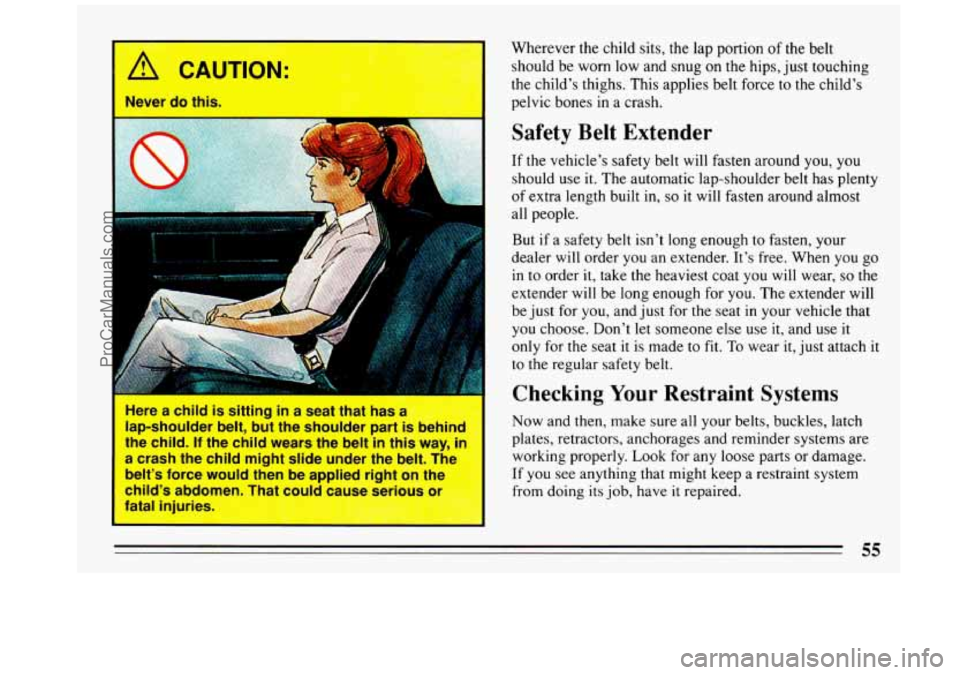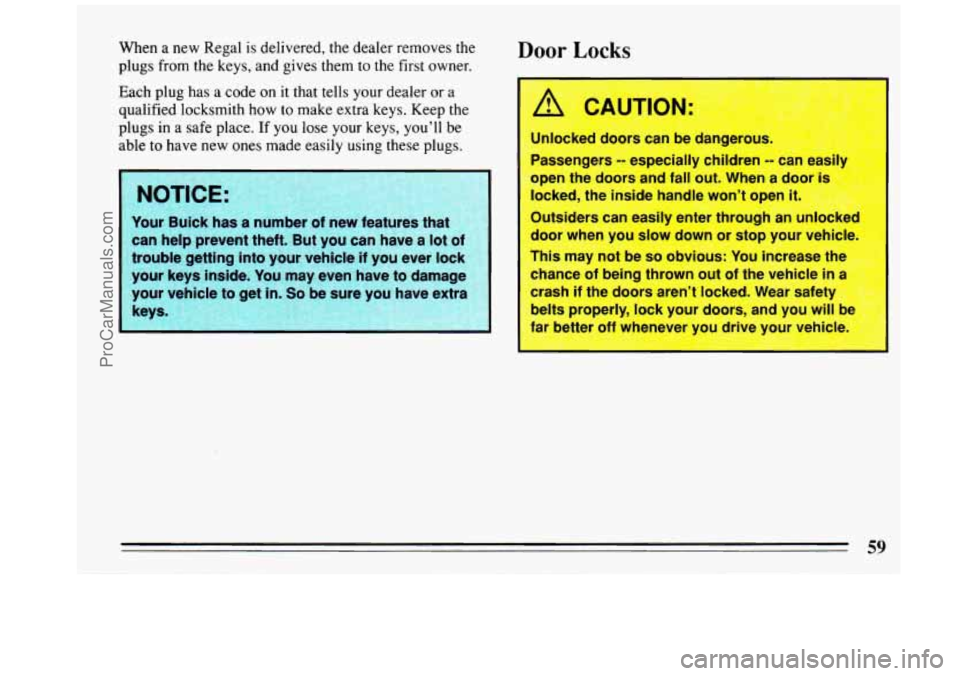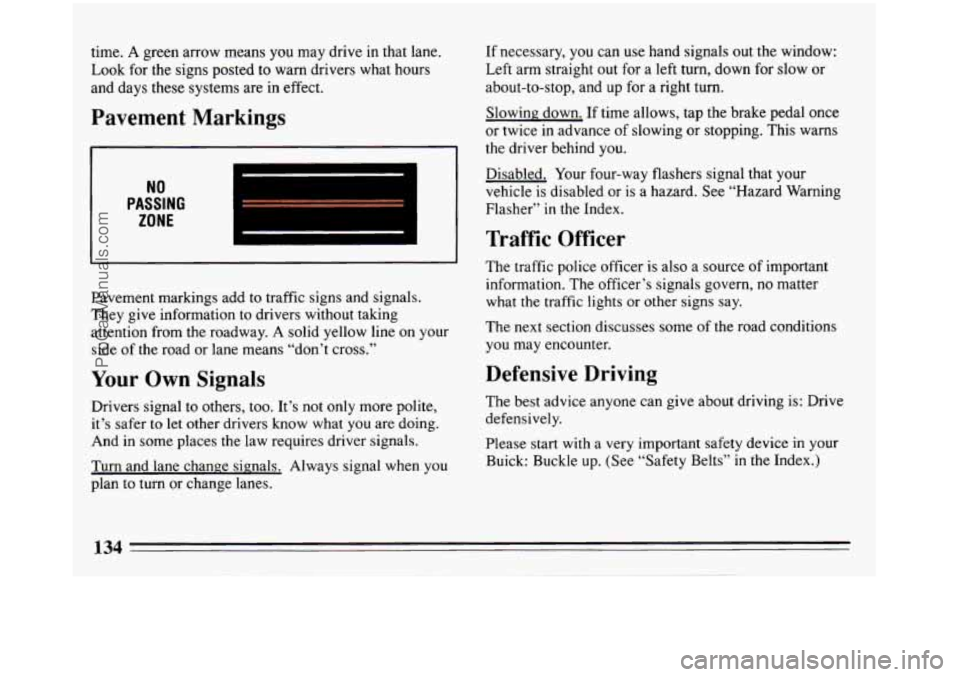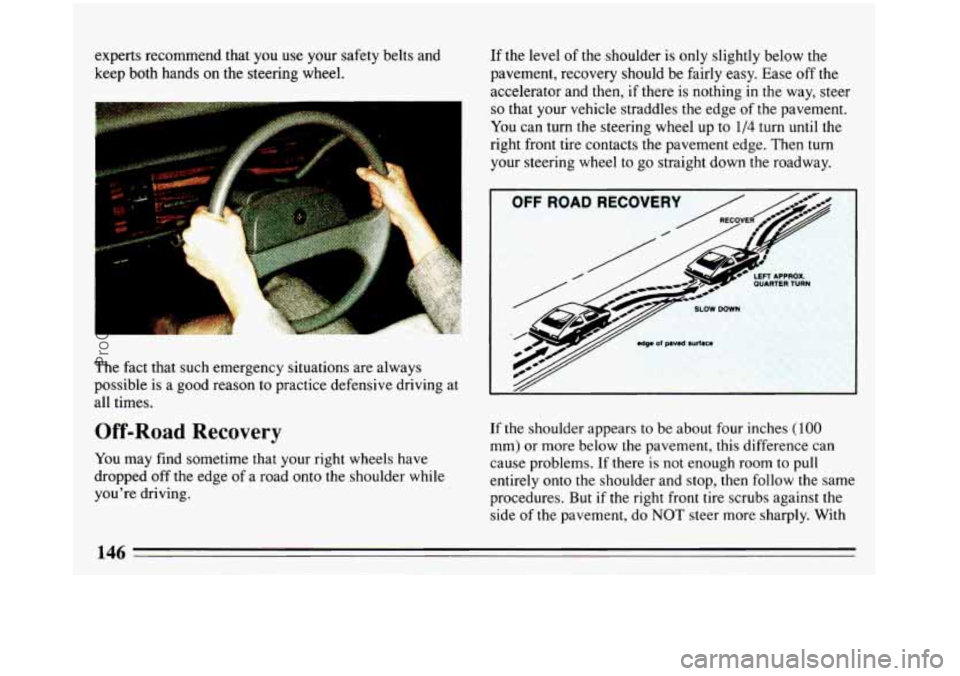Page 54 of 308
To remove the infantkhild seat restraint:
1. Push the button on the safety belt buckle and remove
the special latch plate. Leave the latch plate
on the
special belt. ,.
..
3. Put the belt away in a safe place in your vehicle, so it
won’t
fly around in a crash and injure someone.
4. Remember to reattach the automatic belt again, once
the child restraint is removed. Be sure it isn’t
twisted.
Larger .Children
2. Push the spring on the hook near the door and
remove the special belt.
ProCarManuals.com
Page 55 of 308
Children who have outgrown child restraints should
wear the vehicle’s safety belts.
If you have the choice, a child should sit next to a
window
so the child can wear a lap-shoulder belt and
get the additional restraint a shoulder belt can provide.
Accident statistics show that children are safer if they
are restrained in the rear seat. But they need to use the
safety belts properly.
Children who aren’t buckled up can be thrown out in
a crash.
Children who aren’t buckled up can strike other
people who are.
53
ProCarManuals.com
Page 56 of 308
@ What if a child is wearing a lap-shoulder belt,
but the child
is so small that the shoulder belt is
very close to the child's face or neck?
A: Move the child toward the center of the vehicle, but
be sure that
the shoulder belt still is on the child's
shoulder,
so that in a crash the child's upper body
would have
the restraint that belts provide. If the
child is
so small that the shoulder belt is still very
close to the child's face or neck, you might want to
place the child in the center seat position, the one
that has only a lap belt.
fl h CAUTION:
Ne rdbt
:. .
Here two children are wearing the same belt. I ne
belt can't properly spread the impact forces. In a
crash, the
two children can be crushed together
and seriously injured.
A belt must be used by
only one persor
a+ time, ~- + -. , . .. .-- ,
,- ~ . . . . . . . . ..= . , . ;.: ' -.!:,' .' ..' ,... , - .-
54
ProCarManuals.com
Page 57 of 308

Here a child is sitting in a seat that has a
lap-shoulder belt, but the shoulder part
is Denim
the child. If the child wears the belt in this way, iI
a crash the child might slide under the belt. The
belt’s force would then be applied right on the
child’s abdomen. That could cause serious
or
fatal injuries.
I
Wherever the child sits, the lap portion of the belt
should be worn low and snug
on the hips, just touching
the child’s thighs. This applies belt force to the child’s
pelvic bones in a crash.
Safety Belt Extender
If the vehicle’s safety belt will fasten around you, you
should use it. The automatic lap-shoulder belt has plenty
of extra length built in, so it will fasten around almost
all people.
But if a safety belt isn’t long enough to fasten, your
dealer will order
you an extender. It’s free. When you go
in to order it, take the heaviest coat you will wear, so the
extender will be long enough for
you. The extender will
be just for you, and just for the seat
in your vehicle that
you choose. Don’t let someone else use it, and use it
only for the seat it is made to fit. To wear it, just attach it
to the regular safety belt.
Checking Your Restraint Systems
Now and then, make sure all your belts, buckles, latch
plates, retractors, anchorages and reminder systems are
working properly. Look for any loose parts or damage.
If
you see anything that might keep a restraint system
from doing its job, have
it repaired.
ProCarManuals.com
Page 58 of 308
Replacing Safety Belts After a Crash Q= What’s wrong with this?
If you’ve had a crash, do you need new belts? a
After a very minor collision, nothing may be necessary.
But if the belts were stretched, as they would be
if worn
during a more severe crash, then you need new belts.
If belts are cut or damaged, replace them. Collision
damage also may mean.you will have to have safety belt
parts, like the retractor, replaced or anchorage locations
repaired
-- even if the belt wasn’t being used at the time
of the collision.
I
A: The belt is torn. h, .
A CAUTION:
I
I
I Torn or frayed belts may not protect you in a
I crash. They can rip apart under impact forces. If
a belt is torn or frayed, get a new one right away. I
56
ProCarManuals.com
Page 61 of 308

When a new Regal is delivered, the dealer removes the
plugs from the keys, and gives them to
the first owner.
Each plug has a code on it that tells your dealer
or a
qualified locksmith how to make extra keys. Keep the
plugs in
a safe place. If you lose your keys, you’ll be
able
to have new ones made easily using these plugs.
Your Buick has a number of new features that &$$
can help prevent theft. But you can have a lot of @
trouble getting into your vehicle if you ever lock E:+ g;:
your keys inside. You may even have to damage
your v
keys.
.i ’ 0 I- 7
&?
Door Locks
I
A CAUTIuN:
Unlocked doors can be dangerous.
Passengers
-- especially children -- can easily
open the doors and fall out. When a door is
‘-:ked, the inside handle won’t open
if
Outsiders can easily enter through an unlock€
This may not be
so obvious: You increase the
chance of being thrown out of the vehicle
in a
ash if the doors aren’t locked. Wear safety
belts properly, lock your doors, and you will be
far better off whenever you drive your vehicle.
)or
when you slow down or stop your vehicle.
59
ProCarManuals.com
Page 136 of 308

time. A green arrow means you may drive in that lane.
Look for the signs posted to warn drivers what hours
and days these systems are in
effect.
Pavement Markings
NO
PASSING
ZONE
Pavement markings add to traffic signs and signals.
They give information to drivers without taking
attention from the roadway.
A solid yellow line on your
side of the road or lane means “don’t cross.”
Your Own Signals
Drivers signal to others, too. It’s not only more polite,
it’s safer
to let other drivers know what you are doing.
And in some places the law requires driver signals.
Turn and lane change signals. Always signal when
you
plan to turn or change lanes. If
necessary,
you can use hand signals out the window:
Left arm straight out for a left turn, down for slow or
about-to-stop, and up for
a right turn.
Slowing down. If time allows, tap the brake pedal once
or twice in advance of slowing or stopping. This warns
the driver behind you.
Disabled. Your four-way flashers signal that your
vehicle is disabled or
is a hazard. See “Hazard Warning
Flasher”
in the Index.
Traffic Officer
The traffic police officer is also a source of important
information. The officer’s signals govern,
no matter
what
the traffic lights or other signs say.
The next section discusses some of the road conditions
you may encounter.
Defensive Driving
The best advice anyone can give about driving is: Drive
defensively.
Please start with a very important safety device in your
Buick: Buckle up. (See “Safety Belts” in
the Index.)
134
-
ProCarManuals.com
Page 148 of 308

experts recommend that you use your safety belts ana
keep both hands
on the steering wheel.
The fact that such emergency situations are always
possible is
a good reason to practice defensive driving at
all times.
Off-Road Recovery
You may find sometime that your right wheels have
dropped off the edge
of a road onto the shoulder while
you're driving.
If the level of the shoulder is only slightly below the
pavement, recovery should be fairly easy. Ease
off the
accelerator and then, if there is nothing in the way, steer
so that your vehicle straddles the edge of the pavement.
You can turn the steering wheel up to 1/4 turn until the
right front tire contacts the pavement edge. Then turn
your steering wheel to go straight down the roadway.
OFF ROAD RECOVERY /+-- &-A ..
/
If the shoulder appears to be about four inches (100
mm) or more below the pavement, this difference can
cause problems. If there
is not enough room to pull
entirely onto the shoulder and stop, then follow the same
procedures. But
if the right front tire scrubs against the
side of the pavement, do NOT steer more sharply. With
146
ProCarManuals.com